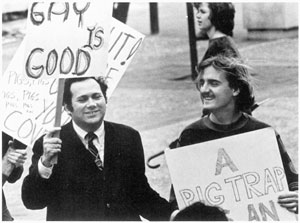|
HOME | SEARCH | ARCHIVE |
|
Doe exhibit showcases Berkeley's
role in 1970s gay lesbian history
![]()
By Cathy Cockrell, Public
Affairs
| |
 This photo from a Sproul Plaza demonstration appeared in an early '70s edition of the campus yearbook, "Blue and Gold.". |
25 October 00 | In Spring 1970, a newly formed Gay Student Union announced Berkeley's first openy gay dance - in Pauley Ballroom, complete with light show and live bands Badwater Rising and Purple Earthquake.
Within 24 hours, a KQED reporter questioned then-California Gov. Ronald Reagan about this unprecedented event at a UC campus. Caught off guard, Reagan responded on camera, "I haven't been invited yet."
To the students, the governor's comment begged for a response.
"We realized we'd forgotten him in the rush," the group wrote in its newsletter, "and immediately printed up 100 invitation letters, complete with an apology, for passers-by to sign." Gay and straight people alike signed and mailed the letters.
A copy of Reagan's personal invitation is among the artifacts campus historians and a local historical society have unearthed for "The Personal Was Political," an exhibit that opened this week in Doe Library's Bernice Layne Brown Gallery.
Subtitled "Gay Liberation and Lesbian Feminism at Berkeley in the 1970s," the show captures the exuberance of the decade in which the gay liberation movement - building on pioneering efforts of homophile organizations of the 1950s and on tactics and rhetoric of the civil rights, anti-war and women's movement of the '60s - erupted across the country.
"There was a lot of serious political and social activism going on at Berkeley during the 1970s, but it was also a time of wicked humor and great fun," notes law librarian William Benemann, who curated the show along with campus staffers James Eason, Steve Finacom and Willyce Kim. Materials came from the Library, the San Francisco-based Gay, Lesbian, Bisexual and Transgender Historical Society, and personal collections.
Lesbian and gay T-shirts occupy one of the show's 14 display cases; another holds an array of flyers announcing campus dances.
A dance "was the gay response to anything," Benemann says. "There was no place to socialize except a few bars, so there was an attempt to build a community."
With photos, fliers, memos, letters, publications, political buttons and articles of clothing, the show documents the women's music scene, lesbian-feminist publishing, the development of a campus political/social community, gay-related counseling and medical services, bars and bathhouses, gay and lesbian elements in popular culture, and several significant individuals, including gay African-American writer James Baldwin, who spoke on campus twice in the '70s.
"The Personal Was Political" also brings to light the role of the campus and the East Bay at the forefront of the gay/lesbian struggle.
Two of the earliest gay liberation organizations in the country, Students for Gay Power and the Gay Liberation Front, were founded on campus in the months following the Stonewall Rebellion, the June 1969 gay uprising in New York City. The cover of an early issue of the Los Angeles Advocate, which later became The Advocate magazine, announces an "Update on New York and Berkeley" found inside.
The curators also have unearthed the 1970 founding charter of the Berkeley-Oakland Women's Union, as well as materials on two East Bay houses that have served as home base for local lesbian-feminist organizers for three decades, and the first lesbian press in the nation, the Oakland-based Women's Press Collective.
Home | Search | Archive | About | Contact | More News
Copyright 2000, The Regents of the University of California.
Produced and maintained by the Office of Public Affairs at UC Berkeley.
Comments? E-mail berkeleyan@pa.urel.berkeley.edu.